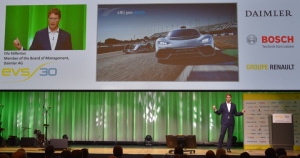The signs are quite clear: Large manufacturers of classic combustion engines are gradually abandoning their traditional fields of activity and investing in hydrogen technology.
In March 2019, for example, MAN Energy Solutions, a classic bus and truck manufacturer and subsidiary of the Volkswagen Group (MAN Diesel & Turbo until 2018), acquired a 40 percent stake in the electrolyser manufacturer H-Tec Systems. Deutz, for decades the epitome of large fossil-fuelled combustion engines, is now cooperating with Keyou and is now working on hydrogen aggregates.
But other major corporations are also gradually taking up positions – both in the gas sector and in the automotive industry: Almost simultaneously with the news described above, the gas company Linde announced that it was setting up a new subsidiary in Vienna called Linde Hydrogen FuelTech GmbH.
Shortly afterwards, the automotive supplier Bosch announced that it would build fuel cells in large numbers in the future. This could give rise to something in the FC sector comparable to the accumulator factory, which has been under discussion for months but is not really making progress.
Even the former oil companies are doing well: Shell management member Maarten Wetselaar announced this in March 2019: “We want to be the world’s largest power company.” In addition to the existing oil, gas and chemicals businesses, the electricity business is to be expanded into a fourth pillar over the next few years. This announcement means nothing other than that within a group of companies, what has so far only been considered, but hardly implemented in the energy sector, could be realised here: sector coupling.
Companies like Shell, which then have access to both the gas network and solar farms and wind turbines, can transfer energy from one sector to another on a large scale using hydrogen as a storage medium. Important economic sectors such as the refinery and steel industries are already involved.
On the other hand, the gas sector is currently lagging somewhat behind: While on the one hand the electricians for the so-called “all-electric-world” demanded the installation of a “copper plate” in Germany in order to distribute green electricity better and to be able to charge electric cars everywhere, on the other hand the gasifiers got increasingly buzzing because they – justifiably – had to fear that their gas network could become superfluous in the future.
Although the entire gas infrastructure will certainly not be uninstalled overnight, the gas associations will have to put up with the question of whether they have not held on to fossil natural gas for too long and thus given up a great deal of room for manoeuvre. Although the DVGW has now entered into cooperation with the DWV, active, transparent cooperation is not yet clearly discernible. For example, the DVGW was unable to answer some critical questions from the H2-international editorial staff about the association’s motivation and objectives.
It should therefore be exciting to observe how the gas sector will further develop in the future. Gas producers in particular are facing new challenges, as the oversized former oil companies are pushing into their traditional business areas. There are voices suggesting that this too was one of the reasons why gas companies have not really pushed the hydrogen sector in the past.
But while on the one hand more and more companies are discovering the H2 and FC sector for themselves, the loss of knowledge seems to continue to advance among German automobile manufacturers. Since many employees in the FC sector in the Stuttgart area in particular once left the local car manufacturer and switched to suppliers, some observers are already asking themselves whether and how this migration of know-how can ever be compensated.
Ola Källenius, the new CEO of Daimler AG, will now have to find the answer. After his predecessor Dieter Zetsche gave up his executive chair in May 2019 after thirteen years, it is now up to the Swede to decide whether and from when fuel cell cars with a star will be leased in series not only in limited numbers, but in mass on the market.


























“The signs are quite clear: Large manufacturers of classic combustion engines are gradually abandoning their traditional fields of activity and investing in hydrogen technology.”
Couldn’t agree with you more. The atmosphere on some ICE assembly lines must be a bit morose these days. That is, for those who haven’t begun to adapt to the new paradigm. Much fewer moving parts in FCs.
You may appreciate the following article which is a perfect confirmation of your well-crafted article:
http://www.wired.com/story/shift-electric-vehicles-strike-gm/?bxid=5cc9dfe824c17c766aa9f943&cndid=44536829&esrc=AUTO_OTHER&source=EDT_WIR_NEWSLETTER_0_DAILY_ZZ&utm_brand=wired&utm_campaign=aud-dev&utm_mailing=WIR_Daily_091719&utm_medium=email&utm_source=nl&utm_term=list1_p4
Looks like with the success of H2, we have all the ingredients for lumpenproletariat frictions… the road to progress isn’t all smooth.